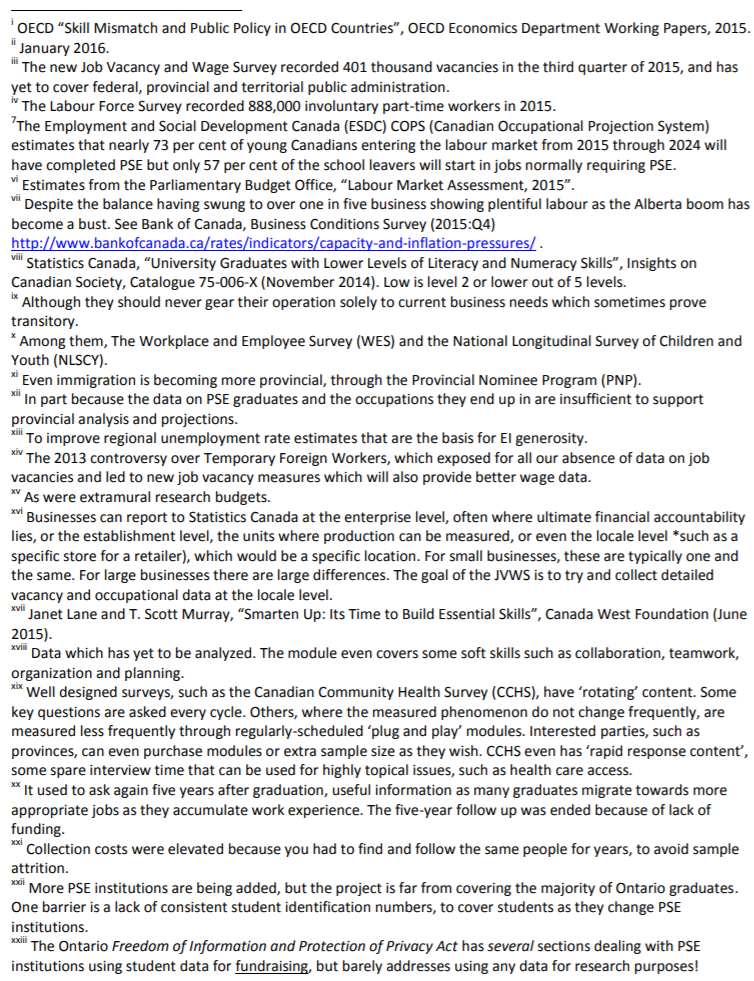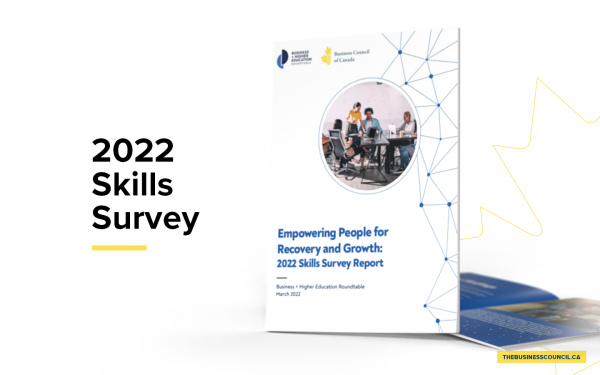Labour Market Information: An essential part of Canada’s skills agenda
Highlights and Recommendations
This paper provides advice to the Business Council of Canada on ways to sustain and develop Canada’s labour market information, widely known as LMI. Reliable and useful jobs data is essential to delivering a well-functioning labour market and, more generally, a strong Canadian economy. Recent work by the Business Council and other groups has underlined the wide range of workplace skills required to achieve these goals. In particular, businesses are increasingly looking for workers with multi-faceted competencies—not just technical knowledge, but also so-called “soft skills” such as collaboration and teamwork, problem-solving, relationship building and an openness to change.
At its best, labour market information provides clear signals that guide the various players towards the most appropriate choices. It helps identify the skills that business needs, and how they can be developed. LMI is critical in matching workers with jobs (and vice versa), and highlighting gaps between the skills that are available and those in need. The entire labour market reaps these benefits:
Students know what education and training to pursue and to what extent their educational credentials will be measured, accredited and transferable.
Educators know what programs best contribute to the economy. In that way, they can better understand what to teach, and how to ensure their graduates’ success in the job market.
Workers better know where the jobs are and what they require.
Immigrants know the opportunities that await them, and the skills they need.
Businesses know what skills are available in the workforce and what gaps need to be filled. Proper information helps inform employers and workers of the potential pay-offs of training.
Governments know which training programs are needed to fill skills gaps. Better program evaluations help policymakers allocate training resources to obtain the most “bang for the buck”. In this way, employers find workers’ skills more closely aligned to their needs, helping them fill job vacancies, bringing down unemployment, and boosting productivity and output.
Canada has no shortage of labour market information. However, the data is fragmented, often hard to access and has many gaps, such as developments in the workplace, the balance of labour demand and supply in local markets, and the longer-term experience of college and university graduates in the labour market, to name just a few.
There have been some encouraging recent developments:
- Employment and Social Development Canada’s Job Bank has made great strides in posting job openings and providing information on required competencies.
- Statistics Canada has introduced a much improved job vacancy survey with greater occupational and regional information.
- Several provinces have built solid labour market information systems, albeit typically confined to their own territories.
- Business groups are showing much greater interest in how to match labour supply and demand, and their members are providing valuable information on labour needs.
Welcome as these actions are, they still fall far short of the robust labour market information system needed to support an effective skills strategy. We have compiled 22 recommendations to improve Canada’s labour market information and, ultimately, the functioning of the labour market and the economy. These recommendations are broadly captured under the following four themes:
1. Stakeholders should coordinate and align their LMI efforts, including developing common survey questions and definitions for comparability across jurisdictions.
- The Forum of Labour Ministers’ new Labour Market Information (LMI) Council should quickly set concrete goals that require active collaboration between the federal government, the provinces and territories.
- In the absence of funding for new data, the LMI Council should quickly develop some labour market information business cases that spell out project benefits, costs and rankings by priority. Without a consensus on priorities, a data plan is just a big “wish list”. The LMI Council should also organize pilot projects for priority activities.
- The LMI Council should co-ordinate provincial and territorial requests for over-sampling in various surveys, along with any other extraordinary requests. Statistics Canada can then appropriately allocate the additional costs. Coordinating these costs should create economies of scale and reduce each jurisdiction’s costs.
- The LMI Council should work with employers, labour, governments and researchers to assess the feasibility of another employer-based Workplace Survey. In particular, it should examine the potential for dovetailing the data with existing administrative sources and the new Job Vacancy and Wage Survey.
- The business sector needs to deepen its understanding of “soft” skills in collaboration with Statistics Canada, the Forum of Labour Market Ministers (FLMM), the Council of Ministers of Education, Canada, schools, colleges, universities and researchers. The goal is to identify more clearly the skills that businesses need, their value, and how they can best be developed and measured.
- Statistics Canada and Employment and Social Development Canada should explore whether the National Occupational Classification’s job definitions can be improved by using the demonstrably useful definitions of literacy, numeracy and problem-solving skill levels incorporated in the Program for the International Assessment of Adult Competencies (PIAAC).
2. There should be an accessible, widely-promoted hub of LMI data at the national level
- Statistics Canada should be allocated an appropriate budget for surveys, analysis and dissemination of labour market information. To this end, Employment and Social Development Canada should transfer its survey budget to Statistics Canada, following the example of Health Canada and its health surveys.
- The government should provide permanent funding to Statistics Canada for the new Job Vacancy and Wage Survey. Once five years of data have been collected, Employment and Social Development Canada should sponsor research to help understand the relationships between job vacancies and labour market strength and weakness.
- Statistics Canada should recommend ways of obtaining more detailed labour market data, focusing on specific geographic areas, industries and occupations. The project should include an estimate of the trade-off between greater granularity and higher cost.
- Business groups should encourage members, especially larger businesses, to improve the quality of their responses to Statistics Canada’s workplace surveys. Those filling out the surveys need to have the necessary knowledge of their companies’ operations.
- Businesses should ensure that job vacancies are posted to Employment and Social Development Canada’s Job Bank, so that the Job Bank becomes the “go-to” place for job searches.
- Business groups should encourage human-resource departments in large businesses to make more effective use of data that is already easily and freely available from Statistics Canada. To that end, they could organize a training course and/or compile a business users’ guide to the data and tools.
- Statistics Canada should conduct a thorough review of the potential for enriched estimates of the non-wage/salary costs of employment, such as health and pension plans, by sector and occupation.
- Statistics Canada and the federal Privacy Commissioner should work with provincial privacy commissioners to draw up a strict but common privacy standard that will enable jurisdictions to share administrative data for research purposes.
3. Data from recent post-secondary graduates should be improved, to help identify the skills gained through education and get better information on employment outcomes by education type.
- Statistics Canada—working with Employment and Social Development Canada, the Forum of Labour Market Ministers’ LMI Council, the Council of Ministers of Education, Canada, and colleges and universities—should enhance the information available on the employment, occupational and earning outcomes for post-secondary graduates. The above players must then ensure that the information is more readily accessible to young people and their parents to support decisions on education and career paths. Initially, these improvements might be achieved by expanding the National Graduates Survey.
- Statistics Canada should spearhead a pilot project to measure the skills characteristics of jobs on employer-based surveys. First, employer groups would need to reach agreement on valid measurements, and businesses would have to demonstrate that knowledgeable employees would be responding to the surveys.
- Statistics Canada should assume responsibility for nation-wide implementation of the project being conducted by the University of Ottawa’s Education Research Partnership Initiative to match student identification numbers with income tax returns with a view to tracking graduates’ employment and income status. This initiative will require backup and coordination support from the Council of Ministers of Education, Canada and the new LMI Council.
- Business groups should work with their members and Statistics Canada to create survey questions that identify the basic skills required for specific jobs.
- Employers will need to step up training for new recruits and existing employees, even if the recommendations in this report to improve the transition from school to work are implemented.
4. Schools and businesses should increase work-integrated learning (WIL) opportunities for students, including co-ops, internships, capstone projects and mentorship programs
- The business sector should expand its contribution to practical workplace learning by providing more internships, co-op placements, part-time employment, presentations, and so on.
- The business sector should work with colleges and universities, including a financial contribution, to address the education and training of scarce, highly specialized workers in fields such as cyber-security.
- Colleges and universities should make a greater effort to understand how a broader perspective on education—including the development of competencies beyond hard skills and discipline knowledge—can improve the well-being of their graduates, and the economy at large.
Real and sustained progress on these recommendations will take efforts from the following lead players: the business community, the federal government, all governments acting together, and educational institutions. Effective implementation is possible and demands a collaborative effort.

Labour Market Information: An Essential Part of Canada’s Skills Agenda
Purpose of this report
This paper provides advice to the Business Council of Canada on ways to sustain and develop Canada’s labour market information, widely known as LMI.
These enhancements are essential if we are to succeed in matching workers’ available knowledge and skills with employers’ needs, both now and in an uncertain future.
Understanding skills
Workplace competencies have two inter-twined dimensions: knowledge and skills. Knowledge encompasses principles, relationships and facts, such as business administration. Skills are the ability to put those principles into action by, for instance, preparing a business plan. The terminology for classifying skills is not standard, but they are often divided into three categories: “foundational”, “soft” and “resiliency” skills. Employment and Social Development Canada (ESDC) combines these categories into nine “essential” skills: writing, numeracy, document use, digital technology skills, oral communication, thinking skills (which include problem solving), working with others, and continuous learning. ESDC has created profiles showing how these skills are relevant to each occupation.
As society moves away from viewing workers as living machines, mindless labourers or cogs in an assembly line, more and more jobs rely on cognitive skills and more developed soft skills. A 2015 Business Council of Canada survey of 90 leading Canadian companies collectively employing 800,000 workers, found that four of the top five capabilities companies look for in entry-level candidates were collaboration, communication, problem solving and people skills— all classified as soft skills.
Some skills are innate. But most can be learned or acquired through experience. A higher skill level makes workers more productive, which is why earnings rise in line with education and work experience, the former typically accumulated over several years after high school, and the latter over three, four or more decades. Skills also make workers more resilient, in other words, able to adapt to inevitable change in a world where people have multiple jobs during their working lives. Generally, higher skills, regardless of how they are acquired, tend to result in improved success in the labour market.
At its simplest, a skills agenda aims to improve the matching of workers with jobs. Workers without jobs (or without jobs commensurate with their skills) and jobs without workers (or without workers well-equipped to perform them) dampen productivity and output, leaving us all worse off. Efficient matching comes from well- informed decisions, which is why labour market information is an essential ingredient of an effective skills strategy.

Why do we need a skills agenda?
We have a problem
Even the most dynamic labour market can never attain a perfect match between every worker and every job. Labour demand will never completely match labour supply across all regions and occupations. There will always be some unemployment as workers change jobs, or do not have the skills or willingness to fill open jobs. Similarly, there will always be job vacancies, whether short or longer term. And, there will always be changes in the job market. Some are slow and steady caused by, for instance, the decline in manufacturing’s share of employment. Others are more sudden, as when commodity cycles or transformative technologies disrupt markets.
Within the OECD, Canada does well in matching workers with jobs. We have the second best record in the share of workers who report being over- or under-qualified for their jobs. Recent data suggests that job vacancies are not high relative to the overall labour force. An Employment and Social Development Canada assessment covering 2012-2014 suggested that a broad, national balance between supply and demand was achieved in 88 per cent of 292 occupations, representing 90 per cent of employment. The latest Business Council of Canada report does not reveal any pervasive skilled labour shortages and cites fairly high satisfaction with recent hires. Most companies are also satisfied that they can cope with forthcoming retirements. Most post-secondary graduates are happy with their jobs and earnings. Indeed, most people are satisfied with their jobs. In Canada, unlike the U.S., real wages have been rising for many workers, not just those at the top.
But “most” does not mean we cannot do better. For starters, out of 19 million people in the labour force, 1.3 million do not have jobs. The unemployment rate, at over 7 per cent, is still well above the lows achieved prior to the last recession.ii Indeed, in 40 years we have never been able to push the national unemployment rate below 6 per cent for a full calendar year. And there are over 400,000 job vacancies.
The list of shortcomings goes on. Nearly 900,000 part-time workers want full-time jobs but cannot find them. There is a continuous inflow of post-secondary graduates into occupations that do not normally require such high qualifications.v More than half a million university graduates aged 25-34 had jobs in 2014 that do not normally require a university education. Meanwhile, the average earnings of recent immigrants remain below Canadian-born workers, despite higher educational qualifications. Indigenous youth represent one of the fastest growing demographic cohorts, yet their employment rates and income remain far below national
average.
On the other side of the coin, businesses are still hampered by shortages of skilled labour. The Bank of Canada’s Business Conditions Survey shows close to one in five respondents reporting a “labour shortage”. Businesses often complain that job candidates lack some of the key “soft skills”. The 2012 Program for the International Assessment of Adult Competencies (PIAAC) showed that 11 per cent of Canadian-born university graduates aged 25-34 had low literacy skills and 17 per cent had low numeracy skills.
The problem will not solve itself
Looking ahead, these mismatches will not dissipate by themselves. More than seven years after the onset of the recession, the economy is still operating below potential. From a business perspective, labour market mismatches have been significantly alleviated by having more workers than jobs in aggregate. But when full employment returns, businesses will have more difficulty finding candidates with the skills that they need. Employers will be under pressure to raise compensation and improve working conditions to attract workers, often from other employers. Those firms unable to improve productivity to offset these higher labour costs may lose market share. These pressures will be exacerbated by very slow growth in the potential labour force, expected to be less than 0.5 per cent a year, versus 1.6 per cent annually from 2006 through 2008.
Other forces are also at work. The good news is that the influx of new skills into the labour force is not about to slow. Young adults and new immigrants—the usual sources of new skills— will ensure that it remains strong. The Canadian Occupational Projection System (COPS), compiled by Employment and Social Development Canada, projects that over 500,000 young people and 120,000 immigrants will enter the workforce each year between 2015 and 2024. On the other hand, outflows from the workforce are set to rise dramatically as retirement numbers soar. The result is that three in every four new entrants to the labour market will be needed to fill existing jobs. Only one in four will be available to fill newly-created positions.
The value of labour market information
Labour market information provides clear signals that guide the various players towards the most appropriate choices. It helps identify the skills that we need, and how best to develop them. It is indispensable in matching workers with jobs (and vice versa), and highlighting gaps between the skills that are available and those that are needed. The entire labour market reaps the benefits:
- Students know what education and training to pursue and to what extent their educational credentials will be measured, accredited and transferable.
- Educators know what programs best contribute to the economy. In that way, they can better understand what to teach, and how to ensure their graduates’ success in the job market.
- Workers better know where the jobs are and what they require.
- Immigrants know the opportunities that await them, and the skills they need.
- Businesses know what skills are available in the workforce and what gaps need to be filled. Proper information helps inform employers and workers of the potential pay-offs of training.
- Governments know which training programs are needed to fill skills gaps. Better program evaluations help policymakers allocate training resources to obtain the most “bang for the buck”.
Canada’s current labour market information
In some respects, we can be proud of Canada’s LMI system—if we were still living in the 1980s. We produce a respectable Labour Force Survey with robust data on labour supply, unemployment and under-employment dating back to 1976. We will soon again have a “long form” census to benchmark detailed labour data every five years. We finally have a credible
measure of job vacancies, after dropping an obsolete version based on newspaper advertising in 2003.
We can even point to some big improvements. For workers seeking jobs and employers seeking workers, things have never been better now that much of the day-to-day job market is on the Internet. Much of Statistics Canada’s data is now available without charge, and can be extensively manipulated with a free and easy-to-use tool (Beyond 2020). Even detailed “microdata” on individuals is available across Canada at 28 highly-regarded research data centres.
But some aspects of our LMI system have deteriorated:
- Long-standing data gaps, such as job vacancies, were not filled for over a decade.
- Even when job vacancies were measured, there was no consistency in methodology.
- Much data is not comparable to earlier periods due to spending cuts, variability, uncertainty and major survey redesigns.
- The 2011 voluntary National Household Survey is not strictly comparable to previous, obligatory long-form census data. Nor is data in the household survey fully comparable to the renewed 2016 long-form census.
- Several long-standing surveys have been terminated.
- Data on wages is weak, especially data on the non-wage components of labour costs.
- Despite the ease of using the Internet for information dissemination, labour market information is difficult to find for those who can benefit, whether students or businesses.
- The data is not always informative, and is often too aggregated to be useful
Perhaps the biggest challenge is that Canada’s labour market information has not kept pace with the “big data” revolution in business, nor with the burgeoning use of highly detailed and high-frequency data that tracks outcomes, choices and preferences among individuals.
To be effective, the labour market information component of a skills agenda must fulfill two conditions:
- Appropriate data must be generated, analysed and disseminated.
- All players in the labour market, whether in government, business, labour and education, must take this data into account in the decisions they make.
Improving the governance structure
Labour market information cannot be properly created, analyzed or disseminated unless specific individuals or agencies have the responsibility, authority AND resources to do so. Responsibility alone is not enough because it limits effective action.
The responsibility, authority and resources need not be limited to a single entity. Some players have a comparative advantage in specific areas. Some have constitutional jurisdiction over specific areas.
Thus, provinces and territories can take on much of the work. Many elements of labour and education are in the provincial domainxi and labour markets are highly regional, with interprovincial migration much lower now than when baby-boomers were young and mobile.
A few provinces have risen to the challenge. In too many cases however, provincial initiatives have fallen short. All too often they are marred by occasional surveys that change each time, inadequate measurement of ill-defined concepts, and small samples. Projections of future labour markets focus too often only on demand, without any information on the adequacy of supply. The result is that users have little confidence in the results. To make matters worse, some provinces do next to nothing.
There is scope for closer provincial collaboration. The Forum of Labour Market Ministers (FLMM), working in conjunction with the Council of Ministers of Education, Canada (CMEC), could play a coordinating role by bringing together the interests of the provinces, territories and the federal government. In some areas, these bodies could facilitate a pooling of resources and standardized data.
Until recently, the Forum of Labour Market Ministers was not active in the field of labour market information. But some stirrings of interest have emerged. The forum is now discussing the formation of a National Stakeholder Advisory Panel and a Labour Market Information (LMI) Council by September 2016.
As we understand it, the new LMI Council would be an independent, non-profit body with a board of directors comprising federal and provincial deputy ministers and the chief statistician of Canada. It would appoint an executive director and a moderate-sized staff, and authorize a budget to cover activities for several years. The chief statistician would play the same kind of expert role that this official already fulfills in the health statistics field through sitting on the board of the Canadian Institute for Health Information.
The big question is what the LMI Council would actually do. The Forum of Labour Market Ministers has said that it wants the council to “work to ensure that information is comprehensive, meets recognized standards, and reflects local labour market realities and needs, while also supporting the development and promotion of a new collaborative platform for disseminating labour market information.” Judging by this directive, the new council would have considerable responsibility, but not much authority and not many resources. In particular, it would lack the resources to fund the extra data needed to ensure that labour market information is “comprehensive” and “reflects local labour market realities”. This means the council should focus on projects that can succeed only with effective collaboration between the federal government, the provinces and territories. One key opportunity would be to jump-start standardization of administrative data collected by different jurisdictions.

In the absence of sufficient resources to generate more data, the council should also be charged with building a strong business case for better labour market information to be submitted to those who can make funding decisions.
We urgently need an in-depth assessment of the needs of potential users of labour market information (in other words, students, post-secondary institutions and employers). We need to hear what type of data would be most beneficial to them (for instance, some measurement of specific skills). This review should include proposals on the most effective mechanisms to disseminate information to users and policymakers in a world of information overload and social media.
The LMI Council will need to avoid the temptation of asking people if they want “free stuff” funded by the federal government. This inevitably leads to yet another long “shopping list”. What is needed is a set of well-argued business cases that set out:
- Specific needs
- The kinds of decisions that such information can support (data that cannot support decisions is just trivia)
- The means of achieving those needs (such as surveys versus administrative data)
- The likely cost of such projects
These business cases then need to be ranked by priority, so that participants understand the opportunity cost of making any given choice (such as a bigger sample size for one survey) over other possible uses of the same resources. Similar business cases should be drawn up for provincial investment, instead of falling back on demands for the government of Canada to “do more”.

Even if the provinces had a better record on labour market information, there still is a strong case for a national perspective. Workers, students and many kinds of businesses are mobile across the country. The government of Canada still selects the majority of immigrants in the skilled worker classes. Substantial economies of scale can be achieved in the collection, analysis and dissemination of data, many stemming from highly-specialized data skills.
If labour market data is to be at all useful, there is an absolute necessity for consistency in how it measures underlying conditions and outcomes.
If definitions vary from province to province, the data from different jurisdictions cannot usefully be compared. If definitions or even sampling methods change over time, the current year’s data cannot be compared to past years or future years. Users cannot even be sure if “up” and “down” or “higher” and “lower” really mean what they say. Without consistent measurement, the data cannot be modelled, whether to analyze factors such as workers’ return to studies in different fields, or the skills that truly matter to employers, or to devise model-based projections. More than that, in a globalized economy where location decisions are among the most important that businesses make, national labour market data must meet international standards so that it can be compared not only within a country but across borders.
Common standards have benefits beyond accurate measurement. They also enable national and sub-national jurisdictions and actors to learn from each others’ best practices. That national perspective need not be assigned to the federal government. It can be provided by the provinces and territories working together. Typically, however, they have not stepped up to the plate. The fact is that most of the robust elements of our current labour market information system have federal parentage.
Statistics Canada has been the main creator of data standards, the main collector and repository for the data and the main protector of the underlying personal information. It has also been the main disseminator of the data, a key source of its basic analysis, and even a source of quality research put into the public domain. The agency has also been instrumental in ensuring comparability of Canadian data with international standards, typically deviating only when there is a strong case for Canada’s own interests to prevail.
Employment and Social Development Canada (ESDC) has been a vital player too. It has worked with Statistics Canada to maintain the National Occupational Classification (NOC) describing jobs, building the Job Bank to put more job vacancies on the Internet via a single portal, and creating a Job Bank feature that allows job seekers to explore occupations by essential skills. ESDC has also funded many data sources, including over-sampling in the Labour Force Survey, a large part of the long-form census prior to 2011, and the new Job Vacancy and Wage Survey. The department also collects valuable administrative data through its labour market programs (especially employment insurance). It has compiled projections of occupational labour demand and supply and labour market gaps since the early 1980s.
Employment and Social Development Canada is also improving its data dissemination. Canadian Occupational Projection System (COPS) projections and documentation are now available online. Its new Explore Careers website, part of Job Bank, does an excellent job of using National Graduates Survey data to convey the range of outcomes that await students in various fields of study.
More recently, however, ESDC’s contribution has become less reliable. Funding for some data sources has been cut. For other projects, it has been uncertain, only to suddenly materialize when an issue becomes politically controversial. The uncertainty is partly because the department has competing demands for funding. The temptation to cannibalize survey budgets for other projects has all too often proven irresistible.
We are confident that existing survey budgets and future funding increases would be safer under the wing of Statistics Canada. That would also give Statistics Canada more scope to smooth the ebb and flow in its survey activities and manage slippages in projects. A transfer of funding from ESDC to Statistics Canada would have to be accompanied by a carefully prepared agreement to ensure that the money would not be diverted to other areas, and that Statistics Canada retained flexibility to launch new projects as opportunities emerged and priorities evolved.


Strengthening the Foundations
A number of glaring gaps have developed in labour market data over the past few decades. Worse, these gaps can never be filled because we can never re-survey the past. We discuss the most egregious cases below.
Job vacancies
No information was available on job vacancies in Canada for seven years from 2003 until 2010. A new Job Vacancy and Wages Survey started in 2015 and ought to provide much more detailed data. The initial surveys covered only vacancies, but information is now also available on persistent vacancies that cannot be easily filled. Subsequent rounds will seek better information on wages.
A challenge for the new survey is to convince respondents, especially larger businesses, that the questionnaire needs to be completed by someone familiar with the relevant human resources situation. With about 100,000 business locations surveyed, the sample is very large. That said, the sample can still easily miss the many specialized vacancies in smaller establishments in highly local job markets.
The survey is funded by fees from firms applying for temporary foreign workers, thus making it a potential hostage to future demand for these workers and to federal government policy on this file. In any event, it will take many years of data to properly analyze the survey results, such as how unemployment and vacancies evolve during recessions and recoveries. Right now, we have no idea what a “normal” vacancy rate is.
The job vacancy survey thus reinforces one of our key messages: Data gaps can never be filled retroactively once they are allowed to develop.
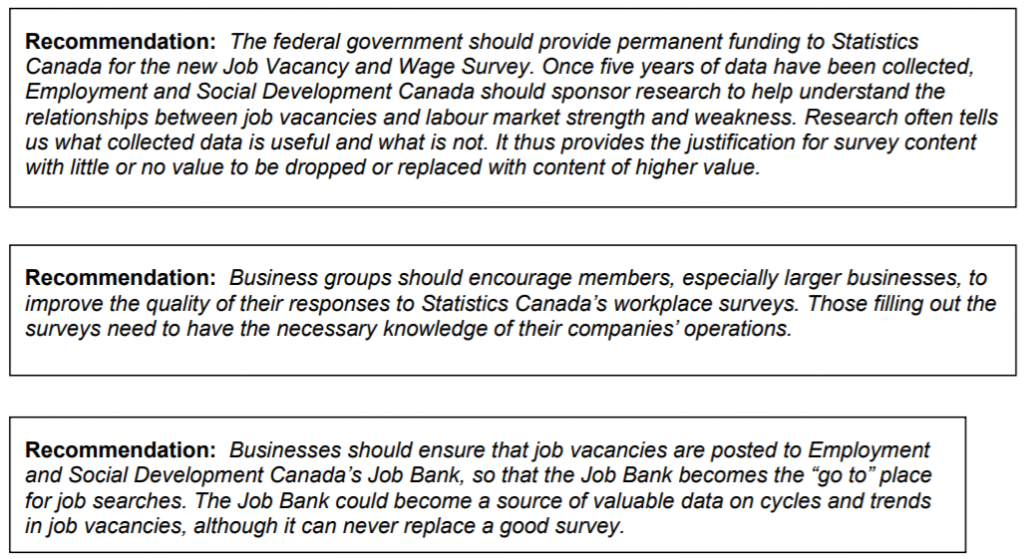
Wages, salaries and benefits
Even Canada’s data on the “price” of labour has limitations. We have many sources of wage and salary data, including the household-based Labour Force Survey and the employer-based Survey of Employment, Payroll and Hours. The new Job Vacancy and Wage Survey will also capture wage data.
But none of these surveys captures other forms of compensation, such as health and pension costs and benefits. These are an important part of the compensation equation. They are likely to be interpreted differently by employees and employers, and are likely to become costlier over time as the workforce ages. A full understanding of Canada’s labour markets requires more comprehensive data on the costs to employers and the benefits to employees of the full spectrum of compensation, including wages and benefits.

The workplace
Little data has been available in recent years on developments and trends in factories, offices and other workplaces. The amount of on-the-job training and how much work is done from home are just two examples of the gaps. Statistics Canada conducted a Workplace and Employee Survey from 1998 to 2006, but little comprehensive information has been available since then. But the survey was of limited value, perhaps because many concepts were nebulous or measured poorly. For example, questions on training were confined to whether or not any took place, rather than how much.
Employment and Social Development Canada funded the collection of data in 2011 for the pilot of a possible replacement, known as the Workplace Survey. But funding for processing the data was not supplied until 2014-15, and a Statistics Canada assessment of the pilot in 2015 uncovered serious problems. Any new survey will have to be carefully designed based on input from employers, labour, governments and researchers to assess the strengths and weaknesses of past efforts and the opportunities for future workplace surveys. Attention will need to be paid both to measureable data and possible linkages with administrative data sources.

Job skill requirements
There are gaps in our knowledge of the education and skills needed for various jobs. The National Occupational Classification (NOC) uses skills to classify jobs, but these are largely based not on the specifics of the skills, but rather on how the skills are acquired (through university, college, completed secondary school, on-the-job training, and so on). The NOC fails to identify even the most basic skills such as language or numeracy. Separately, Employment and Social Development Canada is responsible for developing the Career Handbook that provides more detailed information on a variety of skills within an occupation. However, the handbook was last published in 2003, so the information is badly outdated.
In a paper commissioned by the Business Council, authors at the Canada West Foundation noted that Canada is behind most other industrialized countries in setting out skill requirements for jobs, in particular what they call the “suite” of skills, which would encompass those skills called ‘soft skills’ for example. Surveys like the Business Council’s have recently added
some detail, trying to expand the skills spectrum. But the sample is still small, it varies between surveys, and the questions do not probe deeply enough into the meaning of various skill requirements.
By definition, useful data can only come from survey questions that assess useful skills. This is hard enough to do for literacy and numeracy since, even those basic attributes call for a full, time-consuming set of questions. It is harder still for some of the more nuanced “soft skills” such as teamwork or inter-personal skills. Still, some soft skills can be self-assessed in the way that we are able to describe our own health. Thus, the OECD survey of adult skills, known as the Program for the International Assessment of Adult Competencies (PIAAC), includes a module Recommendation: The new Labour Market Information Council should work with employers, labour, governments and researchers to assess the feasibility of another employer-based Workplace Survey. In particular, it should examine the potential for dovetailing the data with existing administrative sources and the new Job Vacancy and Wage Survey, subject to the Statistics Act’s privacy provisions.
for respondents to self-report on the range of skills they use, both at work and in everyday life. This information need not be measured frequently, in the way that vacancy levels and occupations should be. It could be collected through occasional content modules in surveys. Ideally, the National Occupational Classification will eventually provide more information on skills as part of how an occupation is described and coded.
The OECD is currently doing development work for its next PIAAC adult skills survey, with data to be collected around 2021. Canada and other countries are urging it to improve the measurement of skill use, and to assess whether specific skills can be a proxy for job requirements. If they can, the information can be used to assess skill mismatches. In particular, the goal is to capture the complexity of skills used in a particular job, rather than just how often the skills are needed.
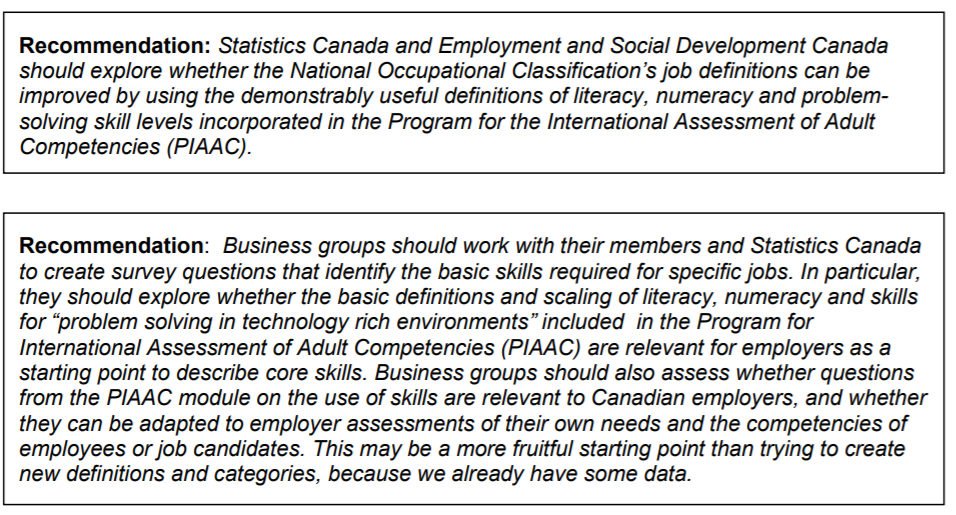
Ideally, Statistics Canada will be able to take over the workplace survey work conducted by the Business Council, as well as other groups such as the Conference Board of Canada and the Chamber of Commerce. Sample sizes can then be expanded and made consistent, and the questions can probe more deeply into the kind of skills that business seeks.

Local labour market information
It is often claimed that there is a need for “local” labour market information, which would offer insight into very specific geographical areas. This deserves careful consideration, given the benefits and drawbacks. The downside of more granular data is lower accuracy, barring very large samples. On the other hand, expanding sample sizes, likely the only way to guarantee reliable local information, is expensive and adds complexity to surveys. It is also worth bearing in mind that expanding sample size is inevitably subject to diminishing returns: 20 per cent more sample does not typically produce 20 per cent more information.
Statistics Canada already over-samples some regions to improve the accuracy of Labour Force Survey estimates of the unemployment rate, used for determining EI benefits. At issue is whether the sample size for the new Job Vacancy and Wage Survey should have the same detail as the Labour Force Survey, so that unemployment can be compared with vacancy data in the same job market.
The answer requires some disciplined analysis of what constitutes a local labour market. Thus, does the Labour Force Survey unit of “southern Nova Scotia” qualify, given that it has a labour force numbering under 100,000? Possibly not. However, a provincial or federal labour information official could likely get a good handle on local conditions by zeroing in on a single city, in this case Yarmouth (population just over 10,000). The official would need only a telephone and a standardized set of questions so that responses are comparable to Cape Breton Island. At the other extreme, can Toronto, with a population of nearly 5.4 million, be considered a single labour market? Possibly yes.

Outcomes for students
Canada has long had inadequate information on college and university graduates’ experience in the labour market. The National Graduates Survey provides a national perspective, but it is only conducted every five years and now looks out only two years beyond graduation. To make matters worse, its sample size is insufficient to provide reliable data for many provinces. Moreover, because of funding uncertainty, the survey for the class of 2010 was not completed until 2013 so that, despite some adjustments, the consistency with earlier surveys was open to doubt.
British Columbia and Ontario have voluntary annual surveys but the samples are relatively small and variable, making the results questionable. In particular, they have grouped many education disciplines together, even though these surveys provide the most valuable data for guiding fieldof-study choices. This is an example where pooled resources would greatly improve data quality. Provinces that want better data can pay for more extensive samples within the federal survey. The provincial view has so far been that the Statistics Canada sampling is too expensive. The agency’s fee model is certainly opaque, but it may be that cheap data has the appearance of inexpensive data, and ends up simply being poor data.

Surveys that follow people over time (Longitudinal surveys)
Longitudinal surveys follow the same people (or families or businesses) over time, tracking changes in their circumstances and outcomes. They are especially useful for analyzing the consequences of specific events, such as the extent to which an older worker is able to replace income after losing a job.
Canada once had a solid record in longitudinal surveys covering children and youth, employment and income dynamics, immigrant experiences, and health. But these have all disappeared, perhaps because – in a tight financial environment – their benefit-cost ratio was considered to be lower given high collection costs and the challenges of sharing the results with researchers due to privacy concerns.
A new longitudinal survey (Longitudinal and International Study of Adults) covers education and skills, jobs and income, health and family. Questions cover the skills used in everyday life outside of work; the importance of certain skills in current and former jobs; the level of skills required; self-assessment of skill improvement and how it came about; and the transferability of structured job-related training. Rich data is also available through program and tax administration for following people through time.
Administrative data
Tapping into data already collected by a government department or agency through ongoing program or tax system administration (and ideally performance measurement) is often more practical than conducting a survey. It has many advantages:
- It is already available.
- It is accurate. For some time now, both employer and household respondents to Statistics Canada surveys have been encouraged to allow the agency to access details of their income from tax filings to the Canada Revenue Agency, leading to much improved accuracy.
- It is “big data”, in other words, a 100 per cent sample.
- It is especially useful for overcoming the all-important challenge of following people over time, enabling researchers, for example, to track workers’ progress several years after completing post-secondary education or a government-funded training initiative.
Canada has a long history of collecting reliable administrative data on personal earnings, through employees’ T1 slips (personal income tax filings to the Canada Revenue Agency), and employers’ T4 earnings filings. Data is also available on individuals’ job history through records of employment (part of employment insurance administration), and landing data on new immigrants. These records can be linked to other data to create a rich source of information.
Thus, the Longitudinal Immigration Database, which links immigrant landing data to Canada Revenue Agency earnings data, has deepened understanding of the issues new immigrants face in finding work at reasonable pay. On another front, Employment and Social Development Canada’s evaluation directorate is linking employment insurance and tax data to address the perennial question of the costs and benefits of programs to train the unemployed.
A promising recent development is work by the University of Ottawa’s Education Policy Research Initiative that helps Statistics Canada link students’ educational qualifications and fields of study with income tax data. This work has clarified the employment and earnings benefits of education not just two years after completion of studies (as the National Graduates Survey does), but for many years beyond.
Complementing this initiative, Employment and Social Development Canada has worked over the past year with the Forum of Labour Market Ministers’ working group on labour market information, Statistics Canada and the Maritime provinces on a pilot study that marries tax data with post-secondary student information. The project is designed to examine experience in the post-secondary education system (such as persistence and graduation rates) and graduate labour market outcomes (such as median employment income). Results are expected by the fall of 2016. With access to the post-secondary student information and tax data, Statistics Canada
has a solid base to expand such work across the country. The work is held back however, by inadequate resources and by institutions’ inability to identify students individually.
The project has much potential. Post-secondary institutions could obtain assessments from their students on literacy, numeracy and problem solving, perhaps even at entrance and at graduation. They could then capture and link that data to better understand the students’ performance during their post-secondary education, and their achievements after graduation.

Despite its many advantages, administrative data also has several drawbacks:
Many sources are poorly defined, maintained and preserved. In many cases, even national programs are run by the provinces, with underlying data lacking common definitions and performance measurements. In such cases, it is misguided to assume that we are collecting cheap or good data, compared with purpose-built surveys that offer consistent sample sizes and content over time. Administrative data is often both cheap and bad, which is worse than no data at all because it creates the illusion that we think we know something when, in fact, we don’t.
Much administrative data (such as tax returns) pertain only to a full year, which means they do not cover the important dynamics of employment and income changes during the course of a year.
Many linkages between various kinds of administrative data are restricted to federal government sources. That means they exclude key information within provincial jurisdiction, such as social assistance (welfare) or health plan data.
Many of the obstacles in sharing such data stem from privacy concerns, in other words, the need to protect personal information captured in administrative data sources. In many cases however, these concerns seem to be a cover for bureaucratic aversion to sharing information and a more general aversion to risk. Statistics Canada has been linking administrative data with census or survey data for years, but most of the time those linked datasets are not made available to potential users in academia, government, business and among the public.
Privacy concerns
The privacy problem is real, but it also has solutions. For starters, the legal issue is not a single statute but a web of federal and provincial laws and rules. Some of these policies do not address the use of data for research at all. Those that do seldom lay out clear guidelines. The solution is both simple and complex.
The simple part is the goal: to create a legal framework for privacy protection that is uniform across Canada. Agencies which meet that standard could then share and use the data for appropriate research and evaluation. A standard framework of protection would make data portable across provincial boundaries in much the same way as the provinces have created a “passport” system for mutual approval of securities prospectuses, or the Red Seal system for recognizing apprenticeship credentials across the country. In the case of administrative data, a highly trusted statistical agency—Statistics Canada—could be the “seed bank” with responsibility for retaining and protecting the information. As is Statistics Canada’s longstanding practice, data would be stripped of any personal identifiers once it was linkedxxiv, and appropriate safeguards would be put in place to minimize the remaining risk of identification.
The complex part is getting to this goal.
Canada’s privacy commissioners should work together to define a standardized legal framework for collecting and sharing administrative data for research purposes. This work should take account of federal and provincial privacy legislation as well as departmental rules, and should provide for federal-provincial sharing, especially with Statistics Canada. The new standards should serve as adequate consent to link related administrative data to survey respondents for research purposes. The provisions would have to include penalties for inappropriate use, similar to those in the federal Statistics Act. Provinces, federal government departments and other institutions should then implement the new guidelines.
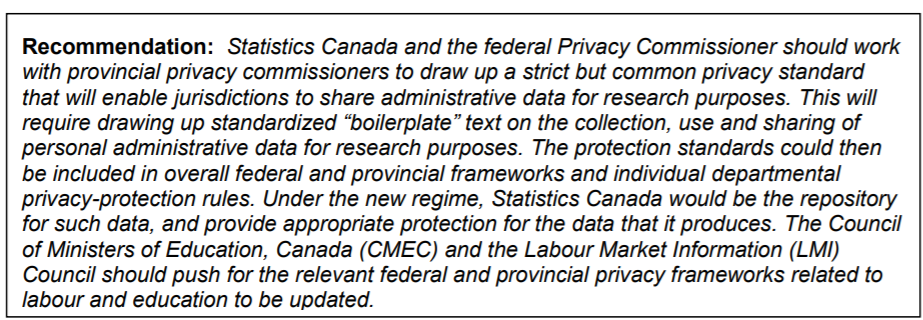

Analysis and Research
How business uses labour market information
Few Canadian individuals or even organizations use raw data from Statistics Canada or other sources. The 2009 Advisory Panel on Labour Market Information did not find any companies that accessed Statistics Canada data directly, not even large consulting firms with human resource practices. This was no surprise at the time: accessing the data was costly, and usually required a knowledge of arcane econometric software.
But times have changed. Much of the data is now free (the result of one of the panel’s recommendation) and it can be accessed with an easy-to-learn and easy-to-use free tool, the Beyond 2020 data browser. Projections of labour demand and supply by national occupation are now online through Canadian Occupational Projection System (COPS) operated by Employment and Social Development Canada. But even with this increased accessibility, the data itself does not appear to be widely used by the private sector.
The Chamber of Commerce has asked its members how they use labour market information for planning purposes. The bottom line is that few do. There are three issues:
- In most cases, users need to know that information exists if they are to find it. At least some labour data is now available and accessible.
- Small- and mid-sized employers do not have the resources to conduct their own labour market analysis. They could benefit if the information was distilled, analyzed and communicated in an appropriate fashion. This need not be the responsibility of the departments or agencies that generate the data. Private groups could customize data for specific end users.
- The information may just not be detailed enough to meet a firm’s needs. Employers often need to understand a very local labour market but cannot do so because of the limits imposed by sample sizes for surveys. The lack of sufficiently local data is reflected in the Chamber of Commerce’s assessment that Canada’s labour market information is not very useful to its members in its present form.
Some business groups and sector councils do play a role in creating, analyzing and disseminating sector relevant information and products. Examples include BuildForce projections and ManufacturingGPS tools. Employment and Social Development Canada supports some of these activities through its sectoral initiatives program.

Use of services such as Job Bank has grown, but it would be useful to examine Employment and Social Development Canada’s evaluation of Job Bank. We worry that Job Bank’s coverage of open jobs and its use by job seekers remains weak. The department is currently evaluating the program through web measurements, focus groups and surveys of businesses and job seekers.
A guide to educational choices
One key gap in labour market information is the longer-term employment and earnings from various levels and fields of post-secondary education. One would assume that young people and their parents look at such evidence before deciding what field of study to pursue. Many young people would benefit from knowing that, two years after graduation, plumbers have an 89 per cent employment rate and earn $68,000 a year, while political science graduates have an 86 per cent employment rate and earn just $52,000. However, the Learning Partnership has discovered that few students or parents are aware of this data and rely instead on far less accurate anecdotal information.
We do not have to look far to understand why this is so. The initial announcement of the 2013 National Graduates Survey consisted of a single line in Statistics Canada’s The Daily noting that the data was available on request—at a fee. The agency published an analysis many months later, but chances are it did not reach a large audience. Further, this data covers employment and earnings for just a few years after graduation, which may not say much about the longerterm prospects of specific occupations.
The good news is that more and more information is now available. At one time, data aimed at students described only the educational qualifications needed to work in a particular field. It did not elaborate on the consequences of obtaining certain qualifications. Fortunately, some of that information is now available on Job Bank’s Explore Careers by Occupation section. This data, drawn from the National Graduates Survey, outlines how many people with a specific educational attainment are employed, how many are working in jobs related to their field of study, and what type of work they are doing if they have moved into careers unrelated to their education.
In 2009, the Advisory Panel on Labour Market Information recommended setting up a central portal from which users could access relevant information. Progress has been made in some provinces on bits and pieces of this project, but not on a broader national scale. Again, the weakness of the governance structure may be standing in the way. Whatever the case, the portal concept may no longer be appropriate, given that young people today are immersed in social media. The new Labour Market Information (LMI) Council should, as part of its consultations, explore the most up-to-date ways of attracting users.
Labour market research
Despite the above concerns, valuable labour market data is already available for research purposes. Statistics Canada’s network of Research Data Centres (run in conjunction with Canada’s major universities, which provide funding and facilities) have generated an immense volume of research on Canadian labour issues. These efforts are especially praiseworthy, given that researchers’ publish-or-perish imperative might normally turn them towards US data. The research centres have access to individual records of respondents, but with personal identifiers removed and a screening process to further protect the data.

Towards a Wider Range of Skills and Life-long Learning
The ultimate purpose of labour market information is to lay the groundwork for better decision-making for the benefit of the entire economy. Yet existing data fails to capture many key dimensions of modern skill sets.
Schools, colleges, universities and students have yet to fully appreciate how much businesses value soft skills. The importance of these skills is evident in recent surveys by the Business Council and others. One hopes that this evidence will persuade educational institutions and students to give more attention to developing and testing skills such as communication, team work and problem solving.
Many colleges and universities across Canada have already launched pilot projects to develop such skills as a complement to the more traditional hard skills and discipline knowledge. But many questions need to be addressed before such efforts can produce meaningful results. On what basis do businesses identify critical soft skills? What evidence is there that employees with these skills enhance a firm’s profitability over time? What are the precise skills that businesses seek in areas such as communication? Do businesses think of these skills in the same way as colleges, universities or students? Do students trained in these broader competencies fare better over time in the labour market?
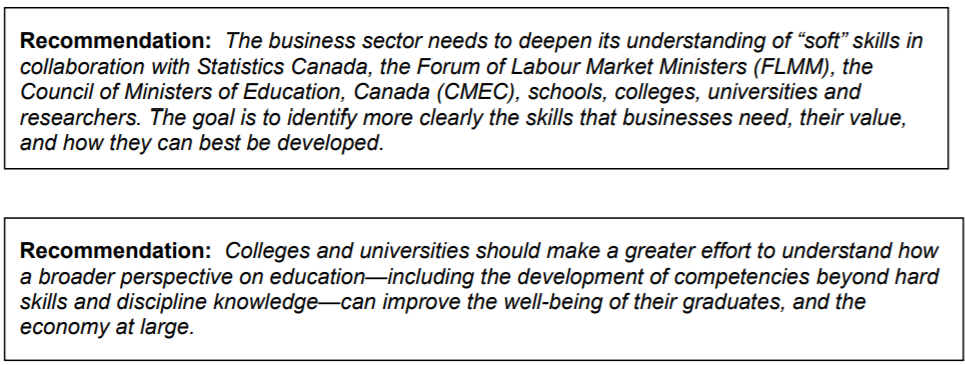
The Business Council’s 2015 survey revealed that some of the most acute skilled labour shortages are in highly specialized areas and involve fairly small numbers of people. The shortage of cyber- security workers is an example. It is unlikely that colleges and universities can address these needs on their own and without extra funding. The business sector needs to work with them to address the education and training aspects of such specific labour needs. That should include a financial contribution. The Global Risk Institute’s work to improve education in financial risk management in the wake of the 2008 financial crisis is a model that could be applied in other sectors.

Recent business surveys underline how internships and co-ops provide the experience that employers value so highly in new recruits. Conversely, surveys and town-hall meetings with young people reveal their desire for more exposure and a better understanding of business before they embark on post-secondary education. While there has been a tremendous expansion of such on-the-job learning, much more can and should be done. Small and midsized firms in particular could participate more actively in internships and co-ops. More businesses could give tours, presentations and part-time work, and be involved in projects with high school students.

Many of the recommendations in this report are designed to help smooth the transition from education to the labour market. But even with these improvements, employers are unlikely to be completely satisfied. Education and skills training in an academic environment will always be somewhat more general than the needs of a specific job—as it should be.
Furthermore, those needs will constantly evolve as the economy shifts and as transitions between different stages of life become more complex. The traditional assumption that life progresses from pre-school to primary to secondary to post-secondary education, then to a lengthy career, and finally retirement is no longer relevant. Life has become a series of transitions, with learning and earning processes that may be simultaneous rather than sequential, and that evolve with ever-changing circumstances.
Our labour market information system, like our learning system, needs to reflect that life-long process of adjusting to change. Much of that process will have to happen in the workplace. Thus, improvements in the education and labour markets envisioned in this report must be reinforced by expanded training by employers. That training should complement workers’ education experience. Of course, the amount of extra training required cannot be pinpointed with any accuracy, if only because one of the many gaps in our existing labour market data is not knowing how much training is already being conducted.


The Key to Success: Collaboration
Canada has squandered many opportunities to build the labour data infrastructure needed to support a robust skills strategy.
The Advisory Panel on Labour Market Information made recommendations in 2009 that would have addressed many of the inadequacies. Implementing these proposals would have cost an estimated $49 million a year, a modest amount when spread among all governments.
However, action was slow in coming due to the murky governance structure for labour market information, insufficient interest from governments and business, and public spending restraint. Indeed, in some respects we went backwards, as funding cuts led to once-valuable surveys being dropped or delayed.
The good news is that interest has recently revived:
- The controversy over the temporary foreign worker program drove home the realization how little is known about actual imbalances between supply and demand.
- Several valuable new initiatives have taken root. The Business Council of Canada, the Chamber of Commerce and the Conference Board have surveyed companies on their labour needs. ESDC funded, and Statistics Canada introduced, improved job vacancy and wage surveys in 2015.
- The Forum of Labour Market Ministers intends to set up a Labour Market Information Council backed by a Stakeholder Advisory Panel.
- Employment and Social Development Canada has strengthened tools such as its Job Bank and Explore Careers by Occupation.
While the renewed interest is encouraging, the measures taken so far still fall far short of the labour market information system needed to support a skills strategy. This report proposes 22 important steps that can and should be taken.
Devising a better system of labour market information will take effort from all the players involved: the business sector, the federal government (especially Employment and Social Development Canada and Statistics Canada), provincial and territorial governments, and educational institutions.
For many of the recommendations, an obvious lead player stands out. But success depends on all working together.
We have noted that Canada has a good labour market information system—if we were still in the 1980s. The need to modernize it has never been greater given the rapid and far-reaching changes taking place in the economy and in the workplace. Reliable and useful labour data can make an invaluable contribution to a stronger business sector, better outcomes for workers, enhanced productivity and sustained economic growth. We should not let the opportunity slip any longer.

Annex 1: Full list of report recommendations
Recommendations for the business community
- Business groups should encourage members, especially larger businesses, to improve the quality of their responses to Statistics Canada’s workplace surveys. Those filling out the surveys need to have the necessary knowledge of their companies’ operations.
- Businesses should ensure that job vacancies are posted to Employment and Social Development Canada’s Job Bank, so that the Job Bank becomes the “go-to” place for job searches.
- Business groups should work with their members and Statistics Canada to create survey questions that identify the basic skills required for specific jobs.
- Business groups should encourage human-resource departments in large businesses to make more effective use of data that is already easily and freely available from Statistics Canada. To that end, they could organize a training course and/or compile a business users’ guide to the data and tools.
- The business sector needs to deepen its understanding of “soft” skills in collaboration with Statistics Canada, the Forum of Labour Market Ministers (FLMM), the Council of Ministers of Education, Canada (CMEC), schools, colleges, universities and researchers. The goal is to identify more clearly the skills that businesses need, their value, and how they can best be developed and measured.
- The business sector should work with colleges and universities, including a financial contribution, to address the education and training of scarce, highly specialized workers in fields such as cyber-security.
- The business sector should expand its contribution to practical workplace learning by providing more internships, co-op placements, part-time employment, presentations, and so on.
- Employers will need to step up training for new recruits and existing employees, even if the recommendations in this report to improve the transition from school to work are implemented.
Recommendations for the federal government
- Statistics Canada should be allocated an appropriate budget for surveys, analysis and dissemination of labour market information. To this end, Employment and Social Development Canada should transfer its survey budget to Statistics Canada, following the example of Health Canada and its health surveys.
- The government should provide permanent funding to Statistics Canada for the new Job Vacancy and Wage Survey. Once five years of data have been collected, Employment and Social Development Canada should sponsor research to help understand the relationships between job vacancies and labour market strength and weakness.
- Statistics Canada and Employment and Social Development Canada should explore whether the National Occupational Classification’s job definitions can be improved by using the demonstrably useful definitions of literacy, numeracy and problem-solving skill levels incorporated in the Program for the International Assessment of Adult Competencies (PIAAC).
- Statistics Canada should spearhead a pilot project to measure the skills characteristics of jobs on employer-based surveys. First, employer groups would need to reach agreement on valid measurements, and businesses would have to demonstrate that knowledgeable employees would be responding to the surveys.
- Statistics Canada should conduct a thorough review of the potential for enriched estimates of the non-wage/salary costs of employment, such as health and pension plans, by sector and occupation.
- Statistics Canada should recommend ways of obtaining more detailed labour market data, focusing on specific geographic areas, industries and occupations. The project should include an estimate of the trade-off between greater granularity and higher cost.
- Statistics Canada—working with Employment and Social Development Canada, the Forum of Labour Market Ministers’ LMI Council, the Council of Ministers of Education, Canada (CMEC) , and colleges and universities—should enhance the information available on the employment, occupational and earning outcomes for post-secondary graduates. The above players must then ensure that the information is more readily accessible to young people and their parents to support decisions on education and career paths. Initially, these improvements might be achieved by expanding the National Graduates Survey.
- Statistics Canada should assume responsibility for nation-wide implementation of the project being conducted by the University of Ottawa’s Education Research Partnership Initiative to match student identification numbers with income tax returns with a view to tracking graduates’ employment and income status. This initiative will require backup and coordination support from the Council of Ministers of Education, Canada (CMEC) and the new Labour Market Information (LMI) Council.
- Statistics Canada and the federal Privacy Commissioner should work with provincial privacy commissioners to draw up a strict but common privacy standard that will enable jurisdictions to share administrative data for research purposes.
Recommendations for federal, provincial and territorial governments acting together
- The Forum of Labour Ministers’ new Labour Market Information (LMI) Council should quickly set concrete goals that require active collaboration between the federal government, the provinces and territories.
- In the absence of funding for new data, the LMI Council should quickly develop some labour market information business cases that spell out project benefits, costs and rankings by priority. Without a consensus on priorities, a data plan is just a big “wish list”. The LMI Council should also organize pilot projects for priority activities.
- The LMI Council should co-ordinate provincial and territorial requests for over-sampling in various surveys, along with any other extraordinary requests. Statistics Canada can then appropriately allocate the additional costs. Coordinating these costs should create economies of scale and reduce each jurisdiction’s costs.
- The LMI Council should work with employers, labour, governments and researchers to assess the feasibility of another employer-based Workplace Survey. In particular, it should examine the potential for dovetailing the data with existing administrative sources and the new Job Vacancy and Wage Survey.
Recommendation for educational institutions
- Colleges and universities should make a greater effort to understand how a broader perspective on education—including the development of competencies beyond hard skills and discipline knowledge—can improve the well-being of their graduates, and the economy at large.

End Notes
